The Read Persian Album
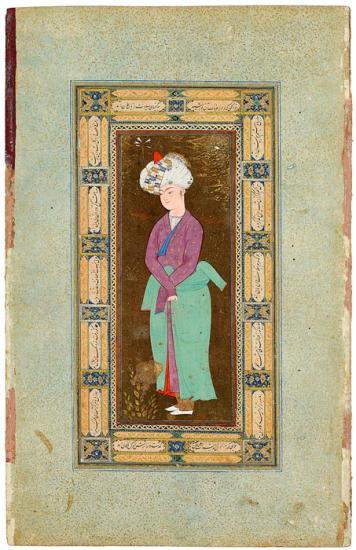
Standing Uzbek Youth
Leaf from the Read Persian Album, signed Muḥammad Mu˒min
Purchased by Pierpont Morgan, 1911
The crossed arms of the standing youth are echoed in the empty coat sleeves tied around his waist. His large turban surrounds a conical orange kulāh of Uzbek type and is crossed diagonally with a richly colored plaid scarf. The leaf is important because the inscription flanking the youth's shoulders is the basis for Ḥusain Shāmlū's ownership of the album: In the library of his successful excellency [whose] watchword is justice/ Ḥusain Khān Shāmlū the governor of Herat. Other leaves are also connected with Herat. Indeed, an inscription near the youth's feet ascribes this work to the painter Muḥammad Mu˒min, whose style derived from his teacher, Muḥammadī of Herat (fl. 1575–83).
The Read Persian Album
Pierpont Morgan's 1911 purchase of two albums (one Persian, one Mughal) from Sir Charles Hercules Read, Keeper of British and Medieval Antiquities at the British Museum, London, proved to be an important turning point in the history of the Morgan Islamic collection. Belle da Costa Greene, Morgan's librarian, accompanied by art historian and collector Bernard Berenson, first saw paintings from the albums at the great exhibition of Islamic art in Munich the previous year. She wrote to Read that they were among the finest works exhibited there and that this important school should be represented in Morgan's collection, asking him to give Morgan the right of first refusal. The Persian album was begun by Husain Khān Shāmlū, governor of Herat (r. 1598–1618), and possibly continued by his son and successor, Hasān Shāmlū (d. 1646). Fifteen of its twenty-seven sheets, once bound accordion style, are presented here. Many of the paintings were made in Herat itself.
Youth Pulling on a Falconer's Glove
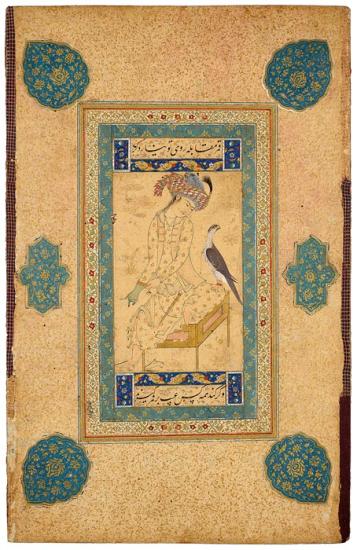
Youth Pulling on a Falconer's Glove
Leaf from the Read Persian Album
Purchased by Pierpont Morgan, 1911
Paintings of young nobleman with their falcons became especially popular during the late sixteenth century. Here a young nobleman, pulling on a leather falconer's glove, gazes at his pet falcon perched on his knee. An elaborate scarf is wrapped around his turban, and a knife hangs from his waist. The bird's red halsband is secured by a gold clasp and red leg bands with bells. This work is after Ḥabīb-Allāh al-Mashhadī, who worked at Ḥusain Shāmlū's court in Herat.
The Read Persian Album
Pierpont Morgan's 1911 purchase of two albums (one Persian, one Mughal) from Sir Charles Hercules Read, Keeper of British and Medieval Antiquities at the British Museum, London, proved to be an important turning point in the history of the Morgan Islamic collection. Belle da Costa Greene, Morgan's librarian, accompanied by art historian and collector Bernard Berenson, first saw paintings from the albums at the great exhibition of Islamic art in Munich the previous year. She wrote to Read that they were among the finest works exhibited there and that this important school should be represented in Morgan's collection, asking him to give Morgan the right of first refusal. The Persian album was begun by Husain Khān Shāmlū, governor of Herat (r. 1598–1618), and possibly continued by his son and successor, Hasān Shāmlū (d. 1646). Fifteen of its twenty-seven sheets, once bound accordion style, are presented here. Many of the paintings were made in Herat itself.
Seated Courtier with His Falcon
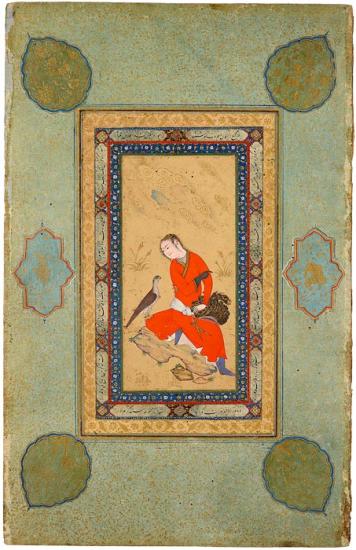
Seated Courtier with His Falcon
Leaf from the Read Persian Album, by Ḥabīb-Allāh al-Mashhadī
Purchased by Pierpont Morgan, 1911
Muslims were noted for their skill and knowledge of falconry. Frederick II, the Holy Roman Emperor (r. 1212–50) ordered Latin translations of works by the Arab falconer Moamin and the Persian Ghatrif. Here a nobleman seems to converse lovingly with his hunting falcon, which rests on his knee rather than on his gloved hand. He wears a skullcap under his turban, and two gold knives dangle from his waist. The gold and silver surfaces have been tooled. The painting is probably by Ḥabīb-Allāh al-Mashhadī (fl. 1595–1610), who worked for Ḥusain Khān Shāmlū in Qazvin and in Herat during the 1590s. He was later taken by Shah ˓Abbās to Isfahan.
The Read Persian Album
Pierpont Morgan's 1911 purchase of two albums (one Persian, one Mughal) from Sir Charles Hercules Read, Keeper of British and Medieval Antiquities at the British Museum, London, proved to be an important turning point in the history of the Morgan Islamic collection. Belle da Costa Greene, Morgan's librarian, accompanied by art historian and collector Bernard Berenson, first saw paintings from the albums at the great exhibition of Islamic art in Munich the previous year. She wrote to Read that they were among the finest works exhibited there and that this important school should be represented in Morgan's collection, asking him to give Morgan the right of first refusal. The Persian album was begun by Husain Khān Shāmlū, governor of Herat (r. 1598–1618), and possibly continued by his son and successor, Hasān Shāmlū (d. 1646). Fifteen of its twenty-seven sheets, once bound accordion style, are presented here. Many of the paintings were made in Herat itself.
Youth Flexing a Bow
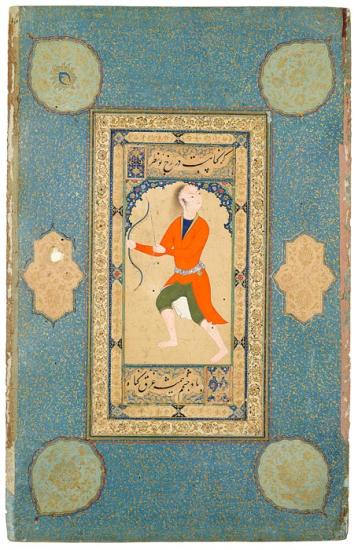
Youth Flexing a Bow
Leaf from the Read Persian Album, after Ḥabīb-Allāh al-Mashhadī.
Purchased by Pierpont Morgan, 1911
One of the exercises practiced by Persian athletes was bow flexing. Such bows, clearly not meant for hunting, were supplied with discs that produced pleasant sounds when shot. According to Sufi belief, a beautiful adolescent is seen as a mirror reflecting a ray of Allāh's beauty and was to be gazed upon. The line of accompanying poetry expands the Sufi idea of gazing at a youth (naẓar ila'l-murd): If it is a sin to gaze upon your face, Then let my eyes be ever drenched in sin. The miniature is after Ḥabīb-Allāh al-Mashhadī, a major painter at Ḥusain Shāmlū's court.
The Read Persian Album
Pierpont Morgan's 1911 purchase of two albums (one Persian, one Mughal) from Sir Charles Hercules Read, Keeper of British and Medieval Antiquities at the British Museum, London, proved to be an important turning point in the history of the Morgan Islamic collection. Belle da Costa Greene, Morgan's librarian, accompanied by art historian and collector Bernard Berenson, first saw paintings from the albums at the great exhibition of Islamic art in Munich the previous year. She wrote to Read that they were among the finest works exhibited there and that this important school should be represented in Morgan's collection, asking him to give Morgan the right of first refusal. The Persian album was begun by Husain Khān Shāmlū, governor of Herat (r. 1598–1618), and possibly continued by his son and successor, Hasān Shāmlū (d. 1646). Fifteen of its twenty-seven sheets, once bound accordion style, are presented here. Many of the paintings were made in Herat itself.
An Aristocratic Smithy
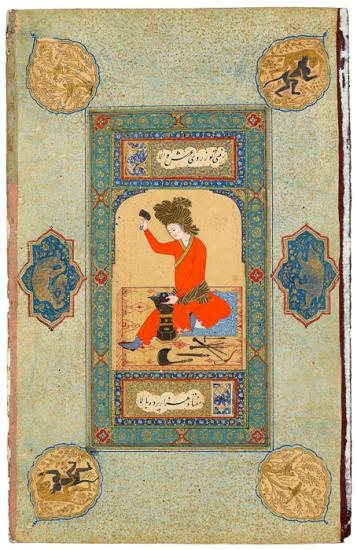
An Aristocratic Smithy
Leaf from the Read Persian, after Ḥabīb-Allāh al-Mashhadī
Purchased by Pierpont Morgan, 1911
Part of a Persian prince's education included gaining proficiency in a craft. For example, Ibrāhīm Mīrzā, the nephew of Shah Tahmāsp (r. 1524–76), excelled in carpentry and made musical instruments. Here a youth in a bright orange robe and henna-stained fingernails is making a horseshoe. This painting and three others in the Read Persian album appear to be copies of lost works by Ḥabīb-Allāh al-Mashhadī, an important painter at Governor Shāmlū's court.
The Read Persian Album
Pierpont Morgan's 1911 purchase of two albums (one Persian, one Mughal) from Sir Charles Hercules Read, Keeper of British and Medieval Antiquities at the British Museum, London, proved to be an important turning point in the history of the Morgan Islamic collection. Belle da Costa Greene, Morgan's librarian, accompanied by art historian and collector Bernard Berenson, first saw paintings from the albums at the great exhibition of Islamic art in Munich the previous year. She wrote to Read that they were among the finest works exhibited there and that this important school should be represented in Morgan's collection, asking him to give Morgan the right of first refusal. The Persian album was begun by Husain Khān Shāmlū, governor of Herat (r. 1598–1618), and possibly continued by his son and successor, Hasān Shāmlū (d. 1646). Fifteen of its twenty-seven sheets, once bound accordion style, are presented here. Many of the paintings were made in Herat itself.
An Uzbek Prisoner
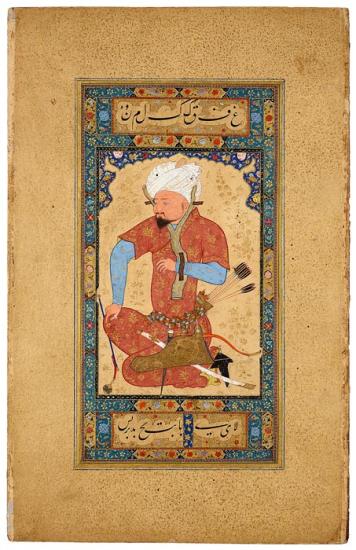
An Uzbek Prisoner
Leaf from the Read Persian Album
Purchased by Pierpont Morgan, 1911
Although the kneeling prisoner is secured by a wooden yoke, he still has his bow (in a case decorated with a simurgh, a mythical phoenix-like bird, chasing a rabbit), quiver, dagger, sword, and a red riding crop (whip). His large white turban features the typical Uzbek striated cone support with a dimpled tip. Although such representations of Uzbek prisoners date back to about 1550, they remained popular until the late sixteenth century, when Uzbek rule came to an end in Herat.
The Read Persian Album
Pierpont Morgan's 1911 purchase of two albums (one Persian, one Mughal) from Sir Charles Hercules Read, Keeper of British and Medieval Antiquities at the British Museum, London, proved to be an important turning point in the history of the Morgan Islamic collection. Belle da Costa Greene, Morgan's librarian, accompanied by art historian and collector Bernard Berenson, first saw paintings from the albums at the great exhibition of Islamic art in Munich the previous year. She wrote to Read that they were among the finest works exhibited there and that this important school should be represented in Morgan's collection, asking him to give Morgan the right of first refusal. The Persian album was begun by Husain Khān Shāmlū, governor of Herat (r. 1598–1618), and possibly continued by his son and successor, Hasān Shāmlū (d. 1646). Fifteen of its twenty-seven sheets, once bound accordion style, are presented here. Many of the paintings were made in Herat itself.
A Young Lady Reclining After a Bath
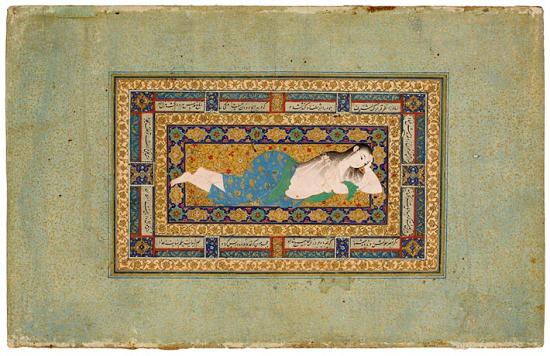
A Young Lady Reclining After a Bath
Leaf from the Read Persian Album, by Muḥammad Mu˒min
Purchased by Pierpont Morgan, 1911
There are depictions of women bathing in Islamic painting. (For example, they appear regularly in Niẓāmī's Khamsa, in which Khusrau sees Shīrīn bathing.) This painting by Muḥammad Mu˒min, however, is not part of a story: it simply depicts a woman daydreaming after her bath. Although ancient statues of Ariadne sleeping and recumbent Venuses by Venetian masters come to mind, no direct influence can be demonstrated. The subject's hips are covered by a blue cloth with rows of golden ducks, which symbolize purity and were used to decorate coverlets for marriage beds. It is doubtless that the young woman thinks only of her beloved.
The Read Persian Album
Pierpont Morgan's 1911 purchase of two albums (one Persian, one Mughal) from Sir Charles Hercules Read, Keeper of British and Medieval Antiquities at the British Museum, London, proved to be an important turning point in the history of the Morgan Islamic collection. Belle da Costa Greene, Morgan's librarian, accompanied by art historian and collector Bernard Berenson, first saw paintings from the albums at the great exhibition of Islamic art in Munich the previous year. She wrote to Read that they were among the finest works exhibited there and that this important school should be represented in Morgan's collection, asking him to give Morgan the right of first refusal. The Persian album was begun by Husain Khān Shāmlū, governor of Herat (r. 1598–1618), and possibly continued by his son and successor, Hasān Shāmlū (d. 1646). Fifteen of its twenty-seven sheets, once bound accordion style, are presented here. Many of the paintings were made in Herat itself.
A Seated Dandy in a Fur-lined Coat
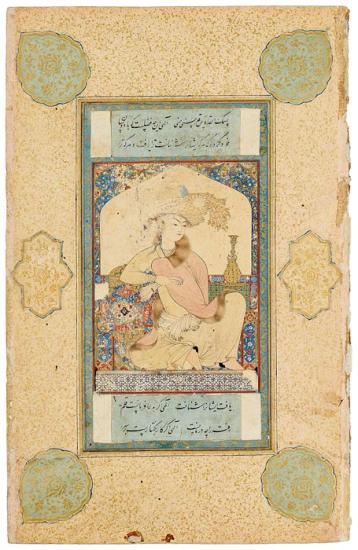
A Seated Dandy in a Fur-lined Coat
Leaf from the Read Persian Album
Purchased by Pierpont Morgan, 1911
The youth pictured here sports an enormous plaid turban, worn over a mottled blue cap. The brown fur lining of his coat is convincingly represented, as are his handkerchief and sash. His right arm is supported with a square pillow decorated with geometric designs around a star and a gold bolster. Behind him is a large golden bottle with matching tray, both studded with precious stones. Although this painting recalls similar works by the contemporaneous Riżā ˓Abbāsī, it cannot be attributed to him.
The Read Persian Album
Pierpont Morgan's 1911 purchase of two albums (one Persian, one Mughal) from Sir Charles Hercules Read, Keeper of British and Medieval Antiquities at the British Museum, London, proved to be an important turning point in the history of the Morgan Islamic collection. Belle da Costa Greene, Morgan's librarian, accompanied by art historian and collector Bernard Berenson, first saw paintings from the albums at the great exhibition of Islamic art in Munich the previous year. She wrote to Read that they were among the finest works exhibited there and that this important school should be represented in Morgan's collection, asking him to give Morgan the right of first refusal. The Persian album was begun by Husain Khān Shāmlū, governor of Herat (r. 1598–1618), and possibly continued by his son and successor, Hasān Shāmlū (d. 1646). Fifteen of its twenty-seven sheets, once bound accordion style, are presented here. Many of the paintings were made in Herat itself.
Lovers Observed by a Youth
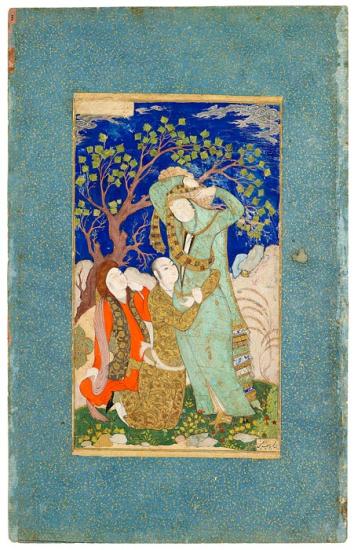
Lovers Observed by a Youth
Leaf from the Read Persian Album, by Muḥammad Yūsuf al-Ḥusainī
Several opinions have been offered regarding this enigmatic trio: has the astonished observer removed his hat because he does not approve of what he sees, or does he raise his finger to his mouth because he is next in line for the courtesan's service? The woman, however, is married, as is indicated by the triangular diadem with an oval flange that hangs over her forehead. She playfully holds her young husband's large turban above his head, its golden sash cascading over her arm and body. The observing youth may be a family member.
The artist was especially fond of depicting rich brocades. The inscription at the bottom states that it is The work of Muḥammad Yūsuf al-Ḥusainī, that at the top, in the library of Ḥasan Shāmlū, Ḥusain's son and successor as governor of Herat. Ḥasan added this work, along with others, to his father's album.
The Read Persian Album
Pierpont Morgan's 1911 purchase of two albums (one Persian, one Mughal) from Sir Charles Hercules Read, Keeper of British and Medieval Antiquities at the British Museum, London, proved to be an important turning point in the history of the Morgan Islamic collection. Belle da Costa Greene, Morgan's librarian, accompanied by art historian and collector Bernard Berenson, first saw paintings from the albums at the great exhibition of Islamic art in Munich the previous year. She wrote to Read that they were among the finest works exhibited there and that this important school should be represented in Morgan's collection, asking him to give Morgan the right of first refusal. The Persian album was begun by Husain Khān Shāmlū, governor of Herat (r. 1598–1618), and possibly continued by his son and successor, Hasān Shāmlū (d. 1646). Fifteen of its twenty-seven sheets, once bound accordion style, are presented here. Many of the paintings were made in Herat itself.
A Man Falls from His Horse
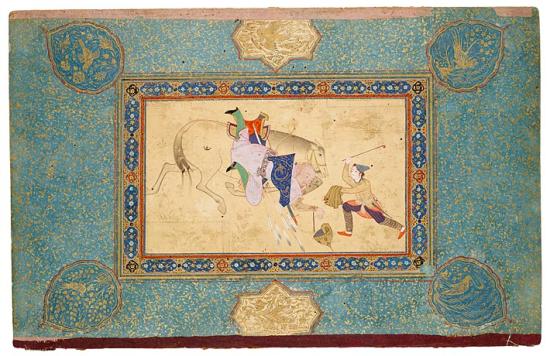
A Man Falls from His Horse
Leaf from the Read Persian Album
Purchased by Pierpont Morgan, 1911
The horse of the heavily armed warrior has stumbled, causing the rider to fall head over heels, dislodging his helmet, knives, arrows, and riding crop. But what is the explanation for the bleeding wound on the top of his head? Has he been struck by his own page? The man has central Asian features, and his horse has slit nostrils and a tail knotted in the Turkman fashion. Men are shown falling off or being pulled from horses in Firdausī's Shāhnāma; perhaps this miniature represents an enlarged detail from such a battle scene. There are some stylistic connections with other miniatures in the Read Persian album, especially those after works by Ḥabīb-Allāh.
The Read Persian Album
Pierpont Morgan's 1911 purchase of two albums (one Persian, one Mughal) from Sir Charles Hercules Read, Keeper of British and Medieval Antiquities at the British Museum, London, proved to be an important turning point in the history of the Morgan Islamic collection. Belle da Costa Greene, Morgan's librarian, accompanied by art historian and collector Bernard Berenson, first saw paintings from the albums at the great exhibition of Islamic art in Munich the previous year. She wrote to Read that they were among the finest works exhibited there and that this important school should be represented in Morgan's collection, asking him to give Morgan the right of first refusal. The Persian album was begun by Husain Khān Shāmlū, governor of Herat (r. 1598–1618), and possibly continued by his son and successor, Hasān Shāmlū (d. 1646). Fifteen of its twenty-seven sheets, once bound accordion style, are presented here. Many of the paintings were made in Herat itself.
Archer Riding an Aged Horse
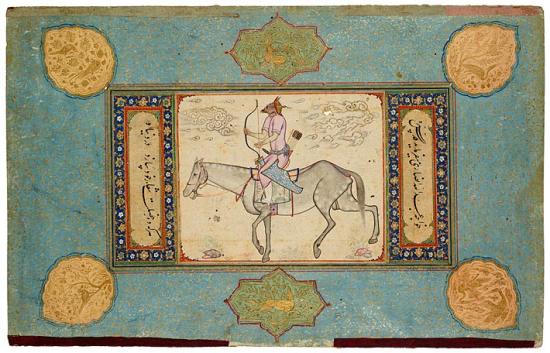
Archer Riding an Aged Horse
Leaf from the Read Persian Album, after Muḥammad Calī Ibn Malik Ḥusain
Purchased by Pierpont Morgan, 1911
The central Asian rider and the exhausted, if not lame, horse find parallels in the works of the Safavid painter Muḥammad ˓Alī Ibn Malik Ḥusain (fl. ca. 1630–60). Recently such images have been seen as a symbol of humility—the necessary suppression of a man's ego (nafs)—one of the main tasks of a Sufi on his spiritual journey. The prose text, from Anṣārī's Munājāt reads: Whoever makes the ten qualities (of the Prophet) his watchword has completed his labor in this world and the next. The leaf was added to the album by Ḥasan Shāmlū, Ḥusain's son and successor as governor of Herat.
The Read Persian Album
Pierpont Morgan's 1911 purchase of two albums (one Persian, one Mughal) from Sir Charles Hercules Read, Keeper of British and Medieval Antiquities at the British Museum, London, proved to be an important turning point in the history of the Morgan Islamic collection. Belle da Costa Greene, Morgan's librarian, accompanied by art historian and collector Bernard Berenson, first saw paintings from the albums at the great exhibition of Islamic art in Munich the previous year. She wrote to Read that they were among the finest works exhibited there and that this important school should be represented in Morgan's collection, asking him to give Morgan the right of first refusal. The Persian album was begun by Husain Khān Shāmlū, governor of Herat (r. 1598–1618), and possibly continued by his son and successor, Hasān Shāmlū (d. 1646). Fifteen of its twenty-seven sheets, once bound accordion style, are presented here. Many of the paintings were made in Herat itself.
Emaciated Horse and Rider
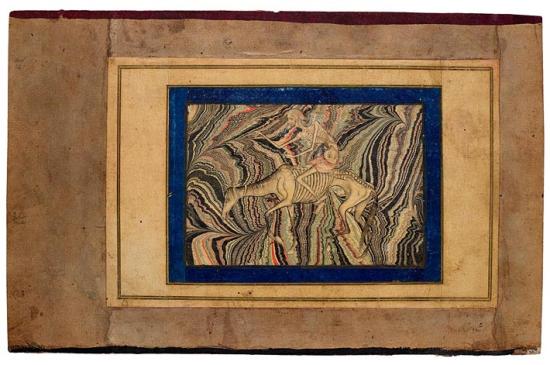
Emaciated Horse and Rider
From the Read Persian Album, first half of the seventeenth century
Purchased by Pierpont Morgan, 1911
Set against a marbled background, a nearly skeletal rider crosses his ankles to stay astride an emaciated horse with no saddle. Other marbled representations of emaciated horses are known, and the motif remained popular in Persian and Mughal painting. For some, the emaciated rider recalls Majnūn, the ill-fated lover of Lailā; while others see connections with European prints of the personification of death on a pale horse. There have also been mystical interpretations. For Rūmī, the starved horse denoted lust (nafs), which faith and reason had to reign in. In India emaciation was associated with ascetics and holy men.
The Read Persian Album
Pierpont Morgan's 1911 purchase of two albums (one Persian, one Mughal) from Sir Charles Hercules Read, Keeper of British and Medieval Antiquities at the British Museum, London, proved to be an important turning point in the history of the Morgan Islamic collection. Belle da Costa Greene, Morgan's librarian, accompanied by art historian and collector Bernard Berenson, first saw paintings from the albums at the great exhibition of Islamic art in Munich the previous year. She wrote to Read that they were among the finest works exhibited there and that this important school should be represented in Morgan's collection, asking him to give Morgan the right of first refusal. The Persian album was begun by Husain Khān Shāmlū, governor of Herat (r. 1598–1618), and possibly continued by his son and successor, Hasān Shāmlū (d. 1646). Fifteen of its twenty-seven sheets, once bound accordion style, are presented here. Many of the paintings were made in Herat itself.
Inhabited Exotic Foliage
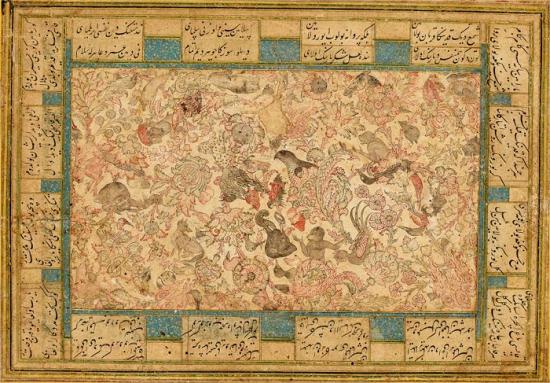
Inhabited Exotic Foliage
Leaf from the Read Persian Album, probably by Riżā Cabbāsī
Purchased by Pierpont Morgan, 1911
Saz, or "enchanted forest" drawings, inhabited with all kinds of creatures, were popular during the sixteenth and seventeenth centuries. This black and red ink drawing contains sixty-two representations—mostly heads of humans, animals, and birds, interspersed among Chinese-style blossoms and leaves. A small hand near the head of the large bird in the upper center points to the date 1625–26, while a second hand above the sitting fox points to an inscription stating that the work is one conferring a gift of Herat.
The drawing is probably by the Persian artist Riżā ˓Abbāsī, who depicted humans and animals in a similar style. The love poem in the border begins and ends with references to the garden where the beloved displays her loveliness and her face.
The Read Persian Album
Pierpont Morgan's 1911 purchase of two albums (one Persian, one Mughal) from Sir Charles Hercules Read, Keeper of British and Medieval Antiquities at the British Museum, London, proved to be an important turning point in the history of the Morgan Islamic collection. Belle da Costa Greene, Morgan's librarian, accompanied by art historian and collector Bernard Berenson, first saw paintings from the albums at the great exhibition of Islamic art in Munich the previous year. She wrote to Read that they were among the finest works exhibited there and that this important school should be represented in Morgan's collection, asking him to give Morgan the right of first refusal. The Persian album was begun by Husain Khān Shāmlū, governor of Herat (r. 1598–1618), and possibly continued by his son and successor, Hasān Shāmlū (d. 1646). Fifteen of its twenty-seven sheets, once bound accordion style, are presented here. Many of the paintings were made in Herat itself.
A Qizilbash and His Horse Entangles by a Dragon
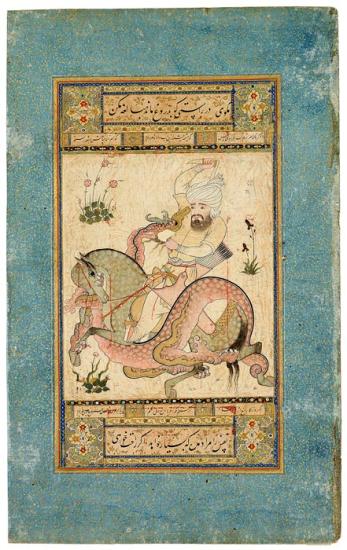
A Qizilbash and His Horse Entangles by a Dragon
Leaf from the Read Persian Album
Purchased by Pierpont Morgan, 1911
The Qizilbash were a group of Shi˓ite Islamic militant groups that flourished from the thirteenth century onward. In 1510 they supported the Timurid ruler Bābur in his war against the Uzbeks and won Samarqand for him. The turbans of the Qizilbash were supported by a high baton. Since such batons were worn in Persia only during the rule of Shah Tahmāsp (r. 1524–76), the painting has been dated to about the middle of the century. Although the hero has a sword and bow, he attacks the dragon with his small dagger. Both the marvelously intertwined horse and dragon are spotted.
The Read Persian Album
Pierpont Morgan's 1911 purchase of two albums (one Persian, one Mughal) from Sir Charles Hercules Read, Keeper of British and Medieval Antiquities at the British Museum, London, proved to be an important turning point in the history of the Morgan Islamic collection. Belle da Costa Greene, Morgan's librarian, accompanied by art historian and collector Bernard Berenson, first saw paintings from the albums at the great exhibition of Islamic art in Munich the previous year. She wrote to Read that they were among the finest works exhibited there and that this important school should be represented in Morgan's collection, asking him to give Morgan the right of first refusal. The Persian album was begun by Husain Khān Shāmlū, governor of Herat (r. 1598–1618), and possibly continued by his son and successor, Hasān Shāmlū (d. 1646). Fifteen of its twenty-seven sheets, once bound accordion style, are presented here. Many of the paintings were made in Herat itself.
Imaginary Fern

Imaginary Fern
From the Read Persian Album
Purchased by Pierpont Morgan, 1911
This apparently imaginary fern is set against a gold background filled with ink drawings of various plants and animals, including the mythical simurgh (phoenix-like bird). The border, containing twelve verses of ˓Urfī's poetry, also includes busts of youths, female-faced suns, and animals by the hand responsible for the ink drawings surrounding the fern. The mount itself is marbled paper, an innovation connected with the court of Sulṭān Ḥusain (d.1506) in Herat. The Frits Lugt Collection, Paris, has a nearly identical fern.
The Read Persian Album
Pierpont Morgan's 1911 purchase of two albums (one Persian, one Mughal) from Sir Charles Hercules Read, Keeper of British and Medieval Antiquities at the British Museum, London, proved to be an important turning point in the history of the Morgan Islamic collection. Belle da Costa Greene, Morgan's librarian, accompanied by art historian and collector Bernard Berenson, first saw paintings from the albums at the great exhibition of Islamic art in Munich the previous year. She wrote to Read that they were among the finest works exhibited there and that this important school should be represented in Morgan's collection, asking him to give Morgan the right of first refusal. The Persian album was begun by Husain Khān Shāmlū, governor of Herat (r. 1598–1618), and possibly continued by his son and successor, Hasān Shāmlū (d. 1646). Fifteen of its twenty-seven sheets, once bound accordion style, are presented here. Many of the paintings were made in Herat itself.